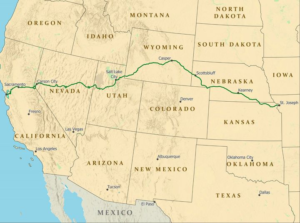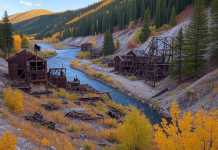The Pony Express made the trip between St Joseph, Missouri and Sacramento, California in 10 days.
Most of the riders were small, wiry men who weighed between 100 and 125 pounds—roughly the same size as a modern horse racing jockey.
Their average age was around 20, but it wasn’t unusual for teenagers as young as 14 to be hired.
 In May 1860, Robert “Pony Bob” Haslam took off on the most legendary ride in Pony Express history. The 20-year-old was scheduled to make his usual 75-mile run from Friday’s Station east to Buckland Station in Nevada.
In May 1860, Robert “Pony Bob” Haslam took off on the most legendary ride in Pony Express history. The 20-year-old was scheduled to make his usual 75-mile run from Friday’s Station east to Buckland Station in Nevada.
Upon arriving at Buckland, however, he found that his relief rider was petrified of the Paiute Indians, who had been attacking stations along the route.
When the other man refused to take the mail, Haslam jumped back in the saddle and rode on, eventually completing a 190-mile run before delivering his mochilla at Smith’s Creek.
After a brief rest, he mounted a fresh horse and retraced his steps all the way back to Friday’s Station, at one point passing a relay outpost that had been burned by the Paiutes.
By the time he finally returned to his home station, “Pony Bob” had traveled 380 miles in less than 40 hours—a Pony Express record.
Pony Express riders had to deal with extreme weather conditions, harsh terrain and the threat of attacks by bandits and Indians, but life may have been even more dangerous for the stock keepers who manned the relief stations.
Their outposts were usually crude, dirt floor hovels equipped with little more than sleeping quarters and corrals for the horses.
Many were located in remote sections of the frontier, making them extremely vulnerable to ambush.
Accounts differ, but Indians reportedly attacked or burned several relay stations during the Pyramid Lake War in the summer of 1860, killing as many as 16 stock hands.
By contrast, only a handful of riders — six, according to the National Park Service, died in the line of duty during the entire history of the Pony Express.
Notes:
During its 18 months of operation beginning in 1860, the Pony Express reduced the time for messages to travel between the east and west US coast to about 10 days. It became the west’s most direct means of east–west communication before the first transcontinental telegraph was established (October 24, 1861), and was vital for tying the new state of California with the rest of the United States.
Despite a heavy subsidy, the Pony Express was not a financial success and went bankrupt in 18 months, when a faster telegraph service was established. Nevertheless, it demonstrated that a unified transcontinental system of communications could be established and operated year-round. When replaced by the telegraph, the Pony Express quickly became romanticized and became part of the lore of the Old West. Its reliance on the ability and endurance of hardy riders and fast horses was seen as evidence of rugged American individualism of the frontier times.
sourced – Wikipedia






